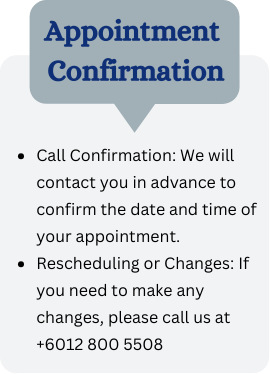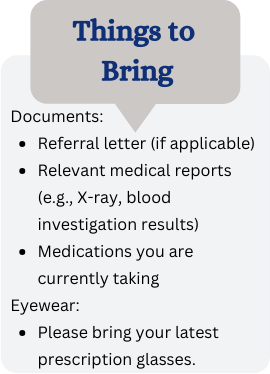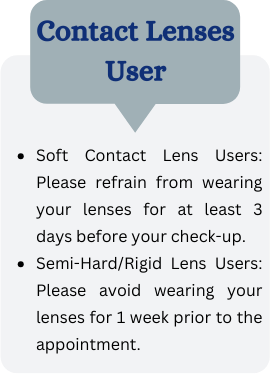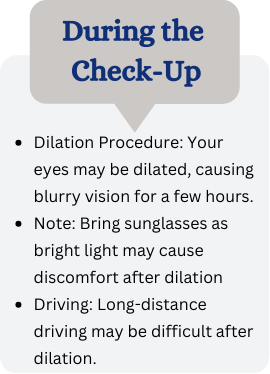Frequently Asked Questions
Thank you for choosing KL Eye Specialist Centre as your preferred eye centre. Below are a few things you can do to facilitate your visit with us.
Your Appointment Checklist: What to Expect and How to Prepare




General Questions
Fees and Charges
No. Each service is charged in accordance to its respective item on the schedule of fees and to the professional that delivers the service to you.
At KL Eye Specialist Centre, you may choose from the following payment methods:
- Cash or Cheque
- Credit Card – Visa or MasterCard (does not accept American Express), Debit Card
- DuitNow QR
- Online Bank Transfer
Kindly inform us regarding your Insurance policy during your registration with us. As different Insurance has a slight difference in their policy, kindly ask your Customer Care Consultant to assist you with your doubts. Certain medical benefits enable the patient to have cashless facility for outpatient treatment. If you are unsure, kindly call the clinic regarding the Insurance Coverage before coming to the clinic as some Insurance may need you to obtain a Referral Letter from your General Practitioner prior coming to the clinic. For the convenience for all the patients at our centre, we are Panel to most of the major Insurance Company available. Kindly bring along your medical card when you come for your check up to ease the transaction. Our staffs will assist you in any way possible to settle your doubts regarding the use of your Medical Card at our centre.
No. Medical report or any other written documentation is not included in the cost of a consultation and a fee will be imposed when you need the Consultant to complete the form. Our staffs will inform you regarding the charges and it may take up to 2 weeks until the form is completed.
You can call our centre at +603-6250 0077 and our friendly customer service will assist you in getting the appointment suitable to your preference or you can send in your inquiry and preferred time through our Whatsapp number (+6012-8005508) and we will revert and confirm your appointment as soon as possible.
We definitely encourage you to make an appointment with us before your visit so that we can be prepared and deliver good services to you as much as possible.
However, we do accept walk-ins as well if you experience unforeseen emergencies that require medical attention from our eye specialists.
You may travel to your clinic by car / hailing services and type “KL Eye Specialist Centre” in the GPS.
Alternatively, you can travel by MRT and the METRO PRIMA station is right in front of our clinic. .
Do not worry! We are open 7 days a week. In any event when we are closed during Public Holidays, our colleague is just a phone call away. Call +6017-6788077 at any time and our colleague will assist you in any way possible.
Others
The distinction between an Ophthalmologist, an Optometrist, an Optician and an Orthoptist is a source of confusion for many people.
An Ophthalmologist is a medical doctor who specializes in all aspects of eye care including diagnosis, management, and surgery of ocular diseases and disorders. They provide primary eye care services including eye exams and prescribe medications and perform surgical procedures.
An Optometrist provides routine vision care. The practice of optometry traditionally involves examining the eye for the purpose of prescribing and dispensing corrective lenses and vision screening to detect certain eye abnormalities.
An Optician fits, adjusts and dispenses eyeglasses or corrective lenses that are prescribed by an ophthalmologist or optometrist.
An optician cannot examine the eyes for disorders or prescribe contact lenses or medication.
An Orthoptist are eye care professionals who specialize in the diagnosis and management of binocular vision problems including Squints and Amblyopia (Lazy Eye).
Cataracts
- Dilate pupil
- Take regular systemic medications as usual (please alert Doctor if you are taking blood thinner / prostate gland medications)
- Make sure blood pressure and blood sugar level are optimal before the surgery
- Preparations in the surgery room – change sterilized clothes, give instructions and demo on operating theatre table
Usually take about 15 minutes, one eye at a time
- Only eye area is exposed
- Eye area will be cleaned
- Small incision on cornea, phacoemulsification to break down cataract and vacuumed, insert artificial lens
- No stitches
- Minimal / tolerable eye pain during the surgery
- Do not worry as you will not be able to blink during cataract surgery
- Eyelids will be widely opened with a speculum
- Eye will be irrigated constantly to keep eye surface moist
- Higher risk of complications in mature cataract / high short-sightedness
- Nucleus drop / posterior capsular rupture
- Phacoemulsification is the usual way (small incision)
- In case of complications during a cataract surgery, ECCE will be employed (larger incision)
- Modern cataract surgery aims to give refractive correction of eye powers
- Everyone has different eye powers including long or short-sightedness, astigmatism and presbyopia
- Everyone has different visual demands and different budget for a cataract surgery
- Different types of lenses with different price ranges suit different needs
- Types of lenses includes: monofocal vs. multifocal; toric vs. non-toric
- Detailed counselling session can guide you to make the most suitable lens for you
- Full recovery takes about one month
- Vision might be blurry on the first day after operation but vision will be clear gradually after few days
- Follow regime to put eye drops
- Take care of personal hygiene
- Do early cataract surgery
Premium Custom Lens Replacement (RLE)
LASIK is a permanent procedure and does not wear off. It works by reshaping your cornea to help your eyes focus light onto the retina more effectively. As you approach your 40s, you might experience blurry near vision due to a natural condition called presbyopia, which is caused by the decreased flexibility of your eye’s lens. This condition is unrelated to LASIK. Presbyopia can be addressed with Refractive Lens Exchange (RLE), which involves replacing your natural lens with an intraocular lens (IOL).
Presbyopia is a natural part of aging where the lens inside your eye gradually loses its flexibility, making it harder to focus on close objects. When you’re young, the lens is highly flexible, allowing easy focus on near tasks. As you age, this flexibility decreases, leading to difficulty with near vision. Presbyopia affects everyone eventually, even those who have never needed glasses before.
As you age, the lens in your eye, which is crucial for focusing light and seeing clearly at various distances, undergoes changes. In your 20s and 30s, the lens is clear and flexible, allowing you to focus on objects at different distances. However, as you enter your 40s, the lens starts to lose its flexibility, a condition known as presbyopia. This results in difficulty focusing on close objects, making multifocal and reading glasses necessary to correct near vision.
During your evaluation, we will conduct a comprehensive assessment of your visual needs and the optics of your eye. Based on this thorough evaluation, we will recommend the IOL technology that best suits your specific needs to achieve the best possible results.

Take the first step towards better eye health today!
Book your appointment now !
Your Trusted Eye Specialist Centre.
Your vision is our priority
our expert team is ready to help you see the world clearly!
